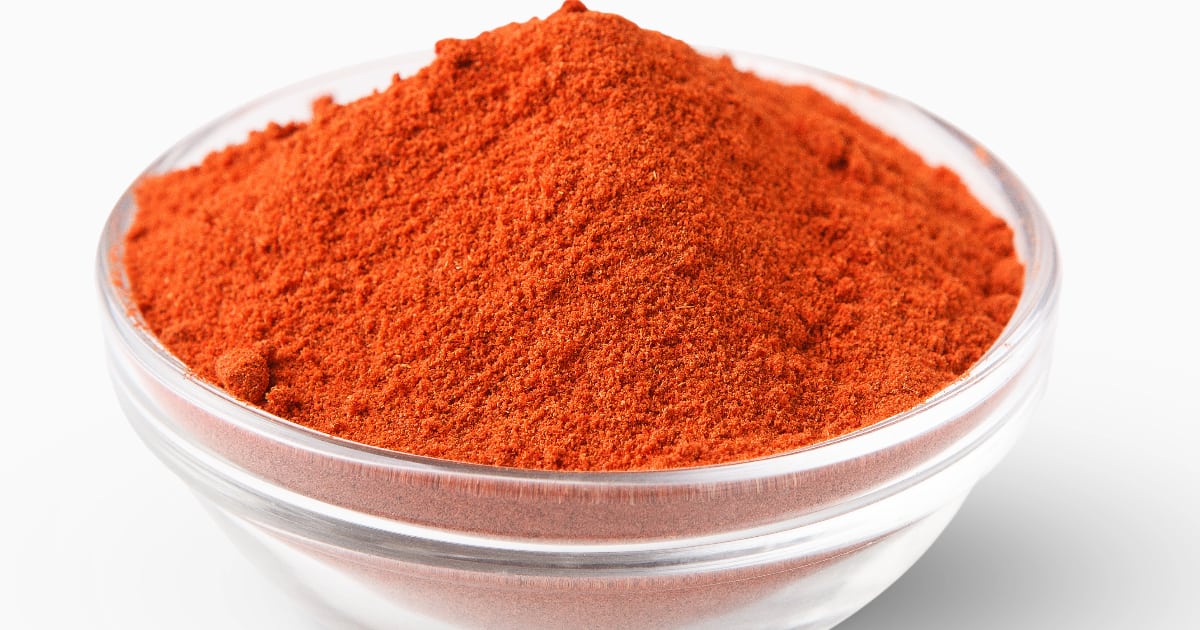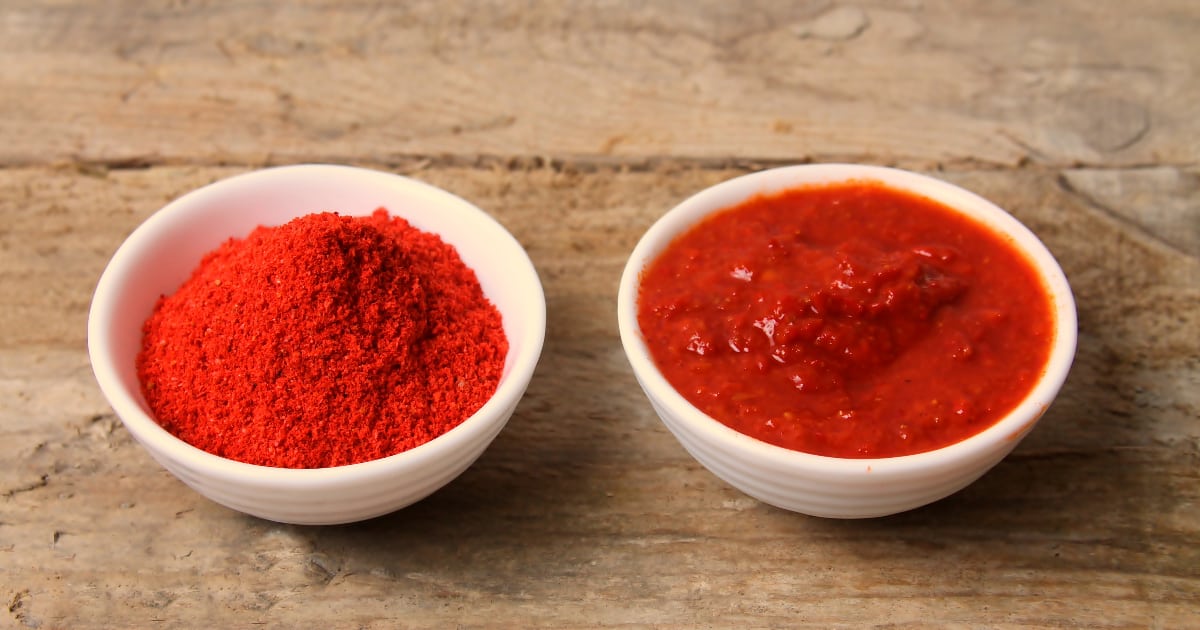Paprika powder is made from grinding dried peppers from the Capsicum annum family, including varieties of sweet peppers like bell peppers and hot peppers like chili peppers. The sweet red peppers create a mild paprika while the spicier peppers make hot paprika. This bright red spice provides vibrant color, smokey flavor, and subtle heat to dishes.

Paprika powder is a staple in spice cabinets around the world, commonly used in chorizo, deviled eggs, hummus, stews, tacos, and more. But what if you've run out of paprika powder mid-recipe? Don't worry, there are plenty of great paprika powder substitutes you likely have on hand.
Cayenne Pepper as a Paprika Substitute
Cayenne pepper makes an excellent paprika substitute, providing a similar vibrant red color. However, cayenne pepper packs much more heat, rating 30,000 to 50,000 Scoville Heat Units compared to paprika's 100 to 500 SHU.
When using cayenne pepper in place of paprika, use very small amounts, about 1/4 teaspoon of cayenne for every 1 teaspoon of paprika powder called for. Then, taste and slowly add more cayenne to reach desired heat level.
Consider adding a touch of sugar or honey to cayenne to balance the heat with sweetness like paprika. You can also tone down cayenne spice by adding cream, broth, or extra salt.
Chili Powder for Paprika's Color and Mild Heat
Another good paprika swap is chili powder. It provides a similar reddish hue and mild spiciness. However, chili powder contains a blend of spices like garlic powder, cumin, and oregano rather than just pure ground chili pepper.
When using chili powder instead of paprika, substitute 1/2 to 1 teaspoon of chili powder for every 1 teaspoon of paprika powder. Start with less chili powder for a milder heat.
Crushed Red Pepper Flakes for a Paprika Kick
Crushed red pepper flakes make a quick and easy paprika substitute, though the texture differs. Red pepper flakes provide paprika's subtle heat and smokiness. But they are made of dried crushed chili peppers rather than finely ground powder.
Replace paprika with about 1/3 to 1/4 teaspoon crushed red pepper flakes per 1 teaspoon of paprika powder called for. Adjust amounts to your desired level of heat.
Chipotle Powder for Smoky, Spicy Paprika
If you want an earthy, richer smoky flavor similar to Spanish smoked paprika, use chipotle powder. It's made from smoked and dried jalapeño peppers. However, chipotle powder is much spicier than regular paprika.
When substituting chipotle powder for regular paprika, use about 1/4 teaspoon of chipotle for 1 teaspoon of paprika. For hot smoked paprika, do an equal 1:1 ratio. Taste and adjust heat as needed.
Bell Peppers for Homemade Paprika Powder
You can even make your own homemade paprika powder by dehydrating and grinding red bell peppers. This makes a sweet, mild paprika substitute.
Slice bell peppers and dehydrate them either in an oven on low heat or using a dehydrator. Once completely dried, grind into a fine powder. Replace paprika powder with about 2 teaspoons of homemade bell pepper powder per 1 teaspoon of paprika.
Tomato Sauce and Chili Powder Combo

For a quick paprika substitute, make a blend using tomato sauce and chili powder. Tomato sauce provides paprika's red color while chili powder adds back heat and smokiness.
Mix tomato sauce and chili powder in a 1:1 ratio. Replace 1 teaspoon paprika powder with 1 teaspoon tomato sauce-chili powder blend. Only use this swap for wet dishes like stews where you can incorporate the sauce.
Ancho Chile Powder for Mild Smoky Flavor
Ancho chile powder makes a wonderfully mild, sweet paprika substitute with just a hint of smokiness. It offers subtle heat ranging from 1,000 - 1,500 Scoville units.
Swap ancho powder in a 1:1 ratio for regular, sweet, or mildly hot smoked paprika. For more heat, add a dash of cayenne pepper.
Cajun Spice Blend for Savory Smoky Paprika
Cajun seasoning contains a blend of paprika, garlic, black pepper, oregano, and cayenne. It makes a tasty substitute for smoked paprika, though often less spicy.
Replace smoked paprika with an equal amount of Cajun seasoning. Adjust amounts as needed based on your brand's spiciness or personal heat preferences.
Guajillo Chili Powder for Hotter Smoky Paprika
For hotter smoked paprika with tangy, fruity flavors, use guajillo chili powder. Guajillo peppers register 2,500-5,000 SHU, so they have more kicks than regular paprika.
Substitute guajillo powder in equal amounts to hot smoked paprika. Start with less guajillo if you want milder heat then adjust to taste.
Aleppo Chili Powder for Moderate Heat
Popular in Mediterranean cooking, Aleppo chili powder provides an earthy, moderately spicy paprika substitute. Its heat falls between paprika and cayenne on the Scoville scale.
When using Aleppo powder instead of paprika, start with 1/2 teaspoon Aleppo per 1 teaspoon paprika, adding more Aleppo to reach desired heat level.
FAQ
What's the difference between paprika and smoked paprika?
Regular paprika is made from dried ground sweet peppers and provides vibrant color with mild heat. Smoked paprika is produced by drying peppers over oak fires, giving it a deep smoky flavor while still maintaining mild heat.
Can you use red bell peppers instead of paprika?
Yes, you can make your own homemade paprika by dehydrating and grinding red bell peppers into powder. This will create a very mild, slightly sweet paprika substitute. Replace store-bought paprika with about 2 teaspoons of homemade red bell pepper powder per 1 teaspoon of paprika powder called for.
Is Aleppo pepper powder just like paprika?
While Aleppo and paprika are both red pepper powders, Aleppo chili powder has its own unique flavor profile. It's commonly used in Mediterranean cooking to season meats, salads, and dips. Aleppo powder provides an earthy, moderately spicy heat that falls between paprika and cayenne pepper on the Scoville scale.
Can you use guajillo chili powder for paprika?
Yes, guajillo chili powder makes a good hot-smoked paprika substitute. Its heat range is 2,500-5,000 SHU, so it's hotter than regular paprika with a tangy, fruity flavor. Replace hot smoked paprika 1:1 with guajillo chili powder or use less for milder heat.
Conclusion
Running out of paprika powder doesn't mean ruining your recipe. With quick fixes like tomato sauce and chili powder or spice cabinet standbys like cayenne pepper, you can easily mimic paprika's bright red hue and subtle smoky heat.
Get creative and play with different combinations and amounts to find your perfect stand-in. Just remember, small amounts of spicy cayenne pepper can go a long way.

